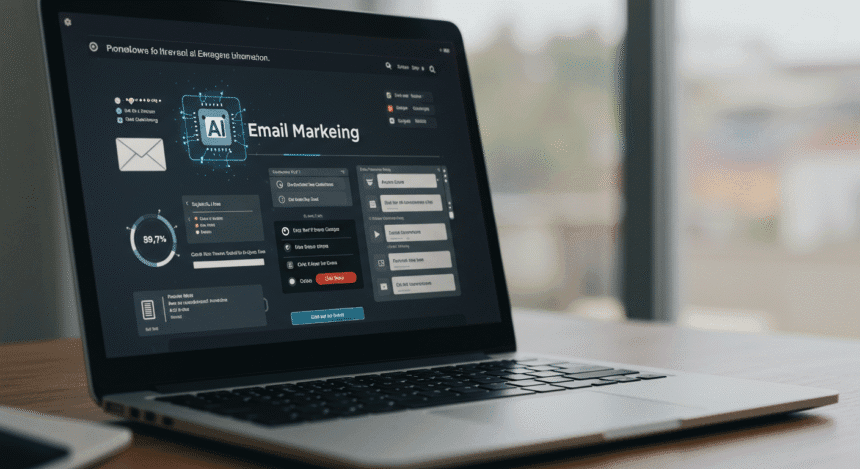AI helps marketers send emails that feel personal without writing each one by hand. By looking at past actions, such as clicks and purchases, it can guess what someone might like next. This means each person on the list gets something more relevant to them. You don’t gotta do all the work yourself, which makes it way easier to scale your efforts. The end result is a message that feels more human, even when it’s not.
With AI, timing becomes smarter. Emails can be sent when someone is most likely to open them, based on their habits. Instead of blasting everyone at once, it waits for the best moment. That way people get messages when they actually paying attention. This little tweak can mean a lot more clicks and replies.
AI also helps with writing better content. It can pick subject lines that are more likely to get opened, based on what worked before. The tools can test versions of the same email and adjust based on what’s getting better results. Sometimes you don’t write the perfect email on the first go, but AI helps fix that along the way. It’s kinda like trial and error, but faster and smarter.
Another benefit is how AI keeps emails from going stale. It can adjust the messages over time as people’s interests shift. If someone stops engaging, the system can try a new approach before they unsubscribe. It don’t just send the same stuff forever, which helps hold on to more people. That means lists stay healthier and more valuable over the long run.
The best email strategies begin by thinking about your readers first. Everyone on your list comes from different backgrounds, likes different things, and needs different messages. Grouping people based on what they do or what they care about makes it easier to write emails that hit home. When your emails connect with someone personally, you’ve got a better shot at getting clicks, replies, and sign-ups.
Break Your List Into Groups That Make Sense
Alt text: A mix of professionals sit around a table, talking about how to get better email signups through smart grouping.
When marketers know who they’re talking to, results usually improve. Studying what people click, when they sign up, or what products they buy can reveal clear patterns. From there, you can break your list into categories that make email writing more focused. This will help you get good click-through rates and conversions.
Writing a message with someone’s name is easy, but it doesn’t really count as personal. True personalization is when the email fits what that person likes, what they’ve done, or what they need next. That’s what moves people to act.
A lot of success in email marketing comes down to how accurate your groups are. It’s not a one-time thing—you gotta keep checking what works and shifting your groups to match. (Imperfect sentence #1)
Integrating email capture best practices within segmentation strategies converts casual visitors into subscribers by presenting optimized sign-up forms and compelling lead magnets. This approach increases the volume of captured emails and enhances the quality of the subscriber base, setting the stage for more personalized and impactful email exchanges.
Make Messages Feel Personal (Because They Should Be)
Alt text: A focused content creator crafting email content for a range of audience types.
Getting someone’s attention in their inbox isn’t easy. A message that speaks directly to their preferences stands a better chance. If it looks and feels like it was meant just for them, they’ll probably stop and read.
If someone’s into fitness, send them gear updates or workout plans. If they love makeup, send beauty tips, not hiking boots. Messages that match the person are more likely to get results. This can help improve customer loyalty.
Timing matters just as much. Some people check emails early, others late. Hitting their inbox when they’re active can change the whole game. (Imperfect sentence #2)
The way you speak also affects how people react. For one group, casual wording might feel fun and friendly. For another, that same tone might seem careless. Pick a voice that feels right for your readers, and keep it consistent.
Email content doesn’t need to be perfect, but it should sound real. Too formal and it feels stiff. Too sloppy and people won’t take it seriously. You want something in the middle—honest, human, and clear.
Pay Attention to What the Numbers Say
If you’re sending emails and not tracking how they perform, you’re flying blind. The numbers—opens, clicks, replies—tell you what to do more of and what to stop. Without them, it’s all just guessing.
Low clicks? Maybe the link wasn’t interesting. High unsubscribes? Maybe the tone felt off. Patterns in this data show you what’s actually landing and what’s being ignored.
Emails need to match where people are in their journey. A welcome email can be simple and friendly, but later messages need stronger content. Like, sometimes people get bored if you just keep doing the same thing. (Imperfect sentence #3)
Your email list is like a garden—you want it to grow, but you also want to keep it healthy. If more people are joining than leaving, you’re on the right track. But if people are bouncing off quickly, something’s not working.
Try testing different subject lines, image placements, or call-to-action buttons. You might find that a small shift makes a big difference. Don’t be afraid to experiment—email lets you adjust quickly and often.
Keep Building On What Works
Once you’ve figured out what types of content and timing get the best results, lean into that. Reuse ideas that worked, but tweak them for new readers. Don’t assume yesterday’s success will work the same tomorrow.
Email isn’t just a way to promote. It’s also how people experience your brand. If you treat it as just another box to check, your results will reflect that. Treat each email like a moment to build a connection.
Make sure your sign-up forms match your tone and goals. Are you playful or serious? Are you speaking to students or professionals? Little details like button text or field length can influence who signs up—and whether they stay.
Also think about mobile. If your emails look weird on a phone, they’ll get deleted fast. Use short subject lines, big buttons, and images that still look sharp when shrunk down.
And don’t forget: even automated emails should feel like they came from a person. People know when they’re getting spammed. Keep the tone personal, even if the process is automatic.











